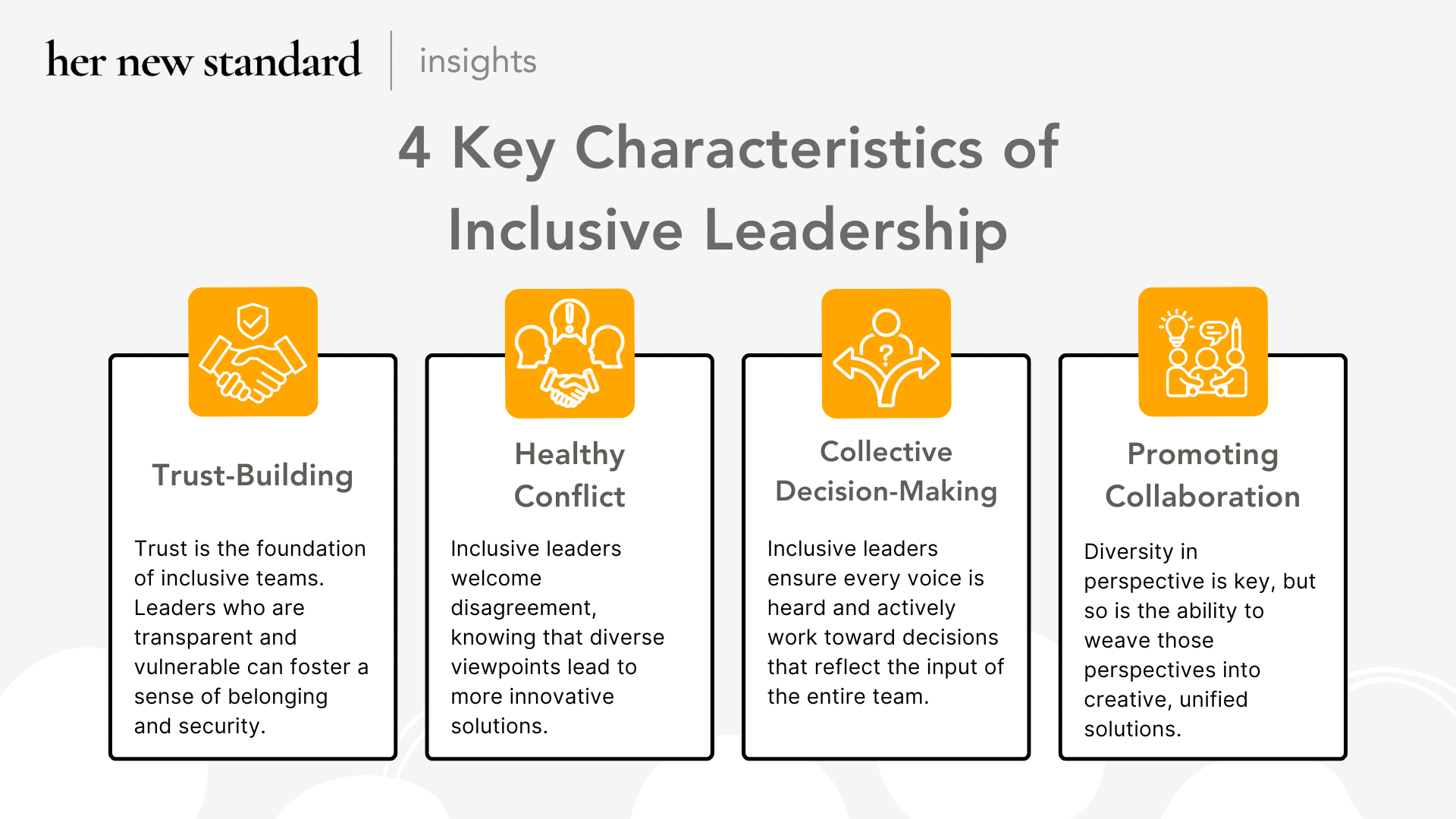Imagine inheriting a crisis so massive it threatens to unravel your entire organization.
That’s exactly what Mary Barra faced over a decade ago when she took the reins at General Motors. Instead of succumbing to the pressure, Barra leveraged the power of inclusive leadership to turn the crisis into a catalyst for profound change. Her approach not only rescued GM from the brink but set a new standard for how inclusivity can transform team dynamics and drive innovation.
Fast forward to today, and the lessons from Barra’s leadership remain as relevant as ever. Inclusive leadership has proven itself as a powerful tool that can elevate any team and drive sustained success.
According to Her New Standard’s Executive Coach, Simone Morris, in her Forbes article Inclusive Teams: What They Are and Why They Matter, inclusive teams are essential for fostering collaboration and innovation. The leadership that cultivates such teams is key to achieving these outcomes. For organizations focused on growth, inclusive leadership is more than just a passing fad. It drives innovation, boosts performance, and ensures a sustained competitive edge.
So what exactly is inclusive leadership and how can you make it work for your team? What are the practical steps you can take to foster inclusivity and elevate your organization? Let’s dive in.
What is Inclusive Leadership?
Inclusive leadership is more than simply making room for diverse voices—it is an intentional practice of creating environments where all team members feel valued, heard, and empowered. At its core, inclusive leadership builds trust, encourages healthy conflict, and fosters collaboration by integrating diverse perspectives into problem-solving. It’s not a top-down directive but a mindset that prioritizes belonging and psychological safety.Key Characteristics of Inclusive Leadership

1. Trust-Building
Trust is the foundation of inclusive teams. Leaders who are transparent and vulnerable can foster a sense of belonging and security.2. Healthy Conflict
Inclusive leaders welcome disagreement, knowing that diverse viewpoints lead to more innovative solutions.3. Collective Decision-Making
Inclusive leaders ensure every voice is heard and actively work toward decisions that reflect the input of the entire team.4. Promoting Collaboration
Diversity in perspective is key, but so is the ability to weave those perspectives into creative, unified solutions.Why Inclusive Leadership Matters
As companies operate on an increasingly global scale, inclusive leadership is a key factor that separates thriving organizations from those that struggle. Let’s break down why it’s so crucial.
Psychological Safety
At the heart of inclusive leadership is psychological safety—the foundation that allows team members to feel confident in expressing their thoughts, ideas, and even disagreements without fear of negative consequences. This sense of security is critical for opening communication and driving innovation. Inclusive leaders are intentional about creating spaces where diverse perspectives are welcomed AND encouraged.
Research from Catalyst’s Three Successful Team Norms That Drive Success supports this. Teams led by inclusive leaders experience higher levels of trust and engagement, leading to more collaboration and creative problem-solving. When employees feel safe to take risks and share their unique viewpoints, the whole team benefits from the richness of ideas that follow.
High-Performing Teams
The link between inclusive leadership and high-performing teams is well-established. Teams that are led inclusively are more adaptive, innovative, and cohesive.
Organizations that prioritize inclusivity see real, measurable outcomes. Inclusive teams bring diverse perspectives and foster environments that lead to better decision-making and innovation.
Deloitte’s research further shows that inclusive companies are 2.3 times more likely to be high-performing and six times more likely to be innovative. This demonstrates that fostering both diversity and inclusion drives stronger performance and profitability.
How to Cultivate Inclusive Environments
Creating an inclusive environment requires more than just awareness; it demands commitment and ongoing learning. The journey begins with assessing your current leadership practices and making necessary adjustments to foster inclusivity.
Assessing Leadership Inclusivity
In our Accelerate program, we use Her New Standard’s Inclusive Leadership Assessment (ILA) as a starting point for leaders looking to evaluate and enhance their inclusivity. Our ILA offers valuable insights into your strengths and areas for growth.
A few sample questions from our ILA can start you thinking about your own inclusive behaviors:
- Do you actively seek out opinions from individuals with different perspectives, and do you listen with genuine openness?
- When you hear others express biases, do you address them and challenge their perspectives?
- Do you mentor or sponsor individuals who differ from you in background, experiences, or viewpoints?
These questions prompt leaders to reflect on their inclusivity practices and initiate dialogues with their teams, fostering a culture of continuous improvement.
Turning Insights into Action
So, what’s next after completing the ILA and gaining insights? How can you translate these insights into actionable steps? Here are strategies to implement the key characteristics of inclusive leadership:
| Key Characteristic | Tangible Actions |
| Trust-Building |
|
| Healthy Conflict |
|
| Collective Decision-Making |
|
| Impact & Promoting Collaboration |
|
Curious to dive deeper into the initial steps? Check out our full article on the 5 Steps to Inclusive Leadership, which outlines actionable strategies for fostering inclusivity in your leadership.
Inclusive Leadership in Action: Learning From Real-World Examples
To see these principles in action, let’s examine what GM got right and by contrast, what Uber did that led to disastrous results.
CASE STUDY 1
Mary Barra’s Inclusive Leadership at General Motors
Mary Barra’s leadership at General Motors offers a compelling example of the power of inclusive leadership. When she took over as CEO in 2014, GM was reeling from a massive recall crisis. Barra didn’t shy away from the challenges but instead embraced transparency and openness. She engaged with employees at all levels, fostering a culture of inclusion that encouraged everyone to contribute solutions. One of her key strategies was to increase employee engagement through town hall meetings, where employees could ask direct questions and offer ideas. Barra also worked to diversify GM’s leadership team, understanding that diverse perspectives were essential for driving innovation. By promoting inclusivity, Barra helped transform GM’s culture, paving the way for new ideas and a brighter future.CASE STUDY 2
Uber’s Leadership Failures
In contrast, Uber’s leadership under Travis Kalanick provides a cautionary tale of what happens when inclusivity is neglected. Kalanick’s aggressive, top-down leadership style fostered a toxic culture where harassment and discrimination flourished. The lack of inclusivity not only damaged Uber’s internal culture but also its public reputation.
The company faced a series of high-profile scandals, leading to Kalanick’s eventual resignation. Uber’s example underscores the importance of collaborative, inclusive leadership—not only for team performance but for an organization’s long-term viability. Neglecting inclusivity can have devastating consequences, from talent attrition to brand damage.
For more information on Inclusive Leadership, check out these great resources:
- A New Way to Combat Bias at Work: An HBR Ideacast
- How to be an Inclusive Leader by Jennifer Brown
- 5 Strategies for Creating an Inclusive Workplace by Pooja Jain-Link
Inclusive leadership is the future—are you ready to embrace it?
At Her New Standard, we know inclusive leadership is essential, which is why it’s a key part of our programs. Our mission is to equip organizations with the tools to create inclusive environments where teams feel empowered to contribute. Interested?
Enjoyed this post? You might also like…




